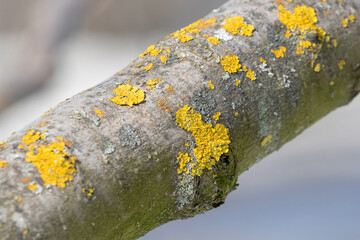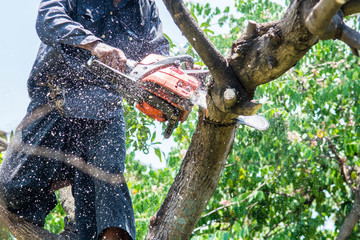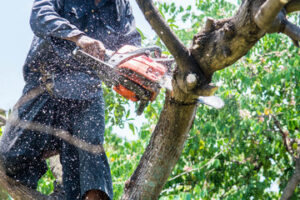Common tree diseases and pests often go undetected for years, slowly building to damaging populations. Symptoms include slowed growth, twig, and branch dieback, premature fall color or seed or cone production, and the presence of mushroom-like or shelf-like fruiting structures on limbs, stems, or trunks.
This fungus infects the xylem, the water and nutrient-conducting tissue of shade trees. Symptoms are primarily slowed growth. Talk to an expert by clicking here at https://www.prvtreeservices.com/.
 Sudden Oak Death
Sudden Oak Death
Sudden Oak Death (SOD) is caused by the pathogen Phytophthora ramorum. It is a water mold that produces spores in humid, moist environments and thrives in California’s damp riparian corridors. These natural highways allow the pathogen to spread and infect a variety of native trees and shrubs. Often, the first sign of infection is a small, reddish-brown lesion that appears in the leaves or twigs of an affected plant. As the disease progresses, the lesion will enlarge and may girdle the trunk of an affected tree or shrub. Infections of trunks generally kill the host.
SOD spreads by airborne spores, splashing water, and root disturbances. It is also spread by people visiting infected forests and landscapes. Mud and debris from infected plants may be carried onto uninfected areas on shoes, clothing, vehicles, bicycles, or horses’ hooves. When the pathogen enters an undisturbed area, it can rapidly spread to neighboring trees and shrubs.
Infected tanoak and black oak are the primary species killed by SOD, but other species such as Coast Live Oak (Quercus agrifolia), Shreve Oak (Quercus parvula var. shrevei), and Pacific madrone (Arbutus menziesii) are sometimes killed as well. SOD can be found in all of our protected forests south, including the heavily visited forests.
Despite the name, Sudden Oak Death does not kill all oaks (Quercus). Rather, it affects primarily oaks from the blue and valley groups. Infections of foliar hosts such as California bay laurel (Umbellularia californica), rhododendrons (Rhododendron spectabilis), and camellias (Camellia japonica) may cause symptoms ranging from leaf spots to twig dieback.
Powdery Mildew
Powdery mildew is a widespread and persistent problem for many plants in the landscape. White to gray powdery spots or blotches cover leaves, stems, flowers, fruits, and terminal shoots of infected plants, making them look like they’ve been sprinkled with flour. If left untreated, the fungus can severely diminish the yields of fruit, vegetables, and ornamentals and reduce their vigor, beauty, and value.
The fungus that causes powdery mildew forms on leaf surfaces, stems, and flowers and can spread to nearby plants via airborne spores. Infected leaves become stunted, distorted, and misshapen. In severe cases, leaves turn yellow, brown, and dry, and the plant may die.
Fungicides and other control measures are available for the disease on many plants. Choose disease-resistant varieties for new plantings or as replacement plants for susceptible ones. Avoid overcrowding plants as this can stress the trees and increase their disease susceptibility. Use a soil test to determine nutrient deficiencies and treat them as needed. Avoid over-fertilizing as this can promote fungus growth.
Generally, a good mowing routine and keeping up with weeding can help prevent the fungus from spreading from year to year on established plants. In addition, spraying with a homemade remedy that consists of baking soda and liquid non-detergent soap can be helpful. It’s most effective as a preventative measure but can also be used as a cure for existing plants.
Mix one tablespoon of baking soda and a half teaspoon of liquid non-detergent soap in a gallon of water and spray liberally on the tops and bottoms of the leaves, including the flower petals and fruits, if any. Repeat weekly if necessary, especially after rain. Milk, which is a natural antibiotic, is very useful as well. It is believed to combat the fungus while boosting the plant’s immune system.
Shot Hole Fungus
Shot hole fungus appears as round to irregular, water-soaked spots on the leaves, buds, and fruit of Prunus spp. family trees including apricot, cherry, peach, and plum. Wet and humid weather promotes the disease, especially in spring. The spots eventually dry out, fall off, and leave multiple holes in the leaf. The fungus can also infect twigs and buds with dark brown to black lesions. Infected fruits often develop rough areas on the skin that resemble scabs. This condition can reduce the amount of viable fruit a tree produces.
Fungicides may help control the disease, but a combination of cultural practices can greatly reduce its incidence. Avoid overhead irrigation to keep plant foliage and buds drier. If you do use a watering system, a dripline or soaker hose is preferred. Prune to provide air circulation, particularly around the trunks of young trees. Removing spore-infected leaves, twigs, and fruit as soon as they show signs of infection is critical.
Infected blossoms, fruit, twigs, and branches can overwinter inside lesion tissue where the fungus will thrive for several months. Pruning to encourage early leaf drop in fall can help reduce inoculum levels and minimize the occurrence of shot holes. An application of lime sulfur during bud dormancy can further decrease inoculum levels and help to control the disease.
While fungicides can help, they must be applied consistently to be effective. Talk to a professional arborist about a preventive fungicide program and other tree care services. Our experienced team can recommend a treatment solution without jeopardizing your property’s health and beauty. We can also help you develop a plan to protect your trees from other diseases and pests.
Sooty Mold
A black fungus that looks like soot, sooty mold develops on the upper surface of leaves and stems. In some cases, this fungus is so thick that it completely covers the leaves and prevents sunlight from reaching plant tissues. This can lead to wilting and leaf damage.
The fungi that cause sooty mold feed on the honeydew excreted by certain sap-sucking insects. These insects include aphids, lace bugs, budworms, beetles, and leafhoppers (including the eucalyptus redgum lerp psyllid), and soft scale insect species. Honeydew is a sweet, sticky liquid that these sap-sucking insects secrete while feeding on a plant. The insects can’t fully digest this fluid so they excrete the excess as waste, leaving it to coat surfaces beneath them where it dries into a sooty-looking substance. The fungi that grow on this residue grow rapidly, and when the fungal growth completely covers leaves, it reduces photosynthesis and causes plants to wilt.
This fungus is usually more of a cosmetic problem than a serious disease and it can be difficult to eradicate. Fungicides containing chlorothalonil or propiconazole can be effective but they must be used regularly for the best results. Home remedies that can help include spraying trees with baking soda (1 tablespoon of baking soda mixed with 1 teaspoon of dish soap or insecticidal detergent in a gallon of water, sprayed every 7 to 14 days) and solutions made from milk (one part milk to two parts water, sprayed every seven to fourteen days).
Sooty mold can be particularly damaging to evergreen shrubs such as azaleas, camellias, crape myrtles, hollyhocks, magnolias, oaks, pines, and viburnums. These shrubs often get sooty mold when the honeydew from insects high in the tree canopy drips down and contaminates the foliage. Hedges and small bushes, such as boxwoods and Indian hawthorn, may also become heavily infested with sooty mold if the trees under which they are planted are heavily infested with insects that produce honeydew.
Fusarium
Fusarium is a widespread fungus that causes wilt disease in many plants. It is also an important soil pathogen, infecting roots, stems, and xylem vessels of trees and shrubs. The fungus invades through wounds and takes advantage of the favorable conditions in the soil, especially high humidity and temperature, to germinate and develop.
The fungus produces several types of spores, called chlamydospores and conidia. The chlamydospores have thick walls that make them resistant to drying, and they can survive for long periods in the soil. The conidia are thin-walled and can be long and multi-celled (macroconidia) or short and one-celled (microconidia). These spores are produced in masses of conidiophores, which grow together like a tuft or sporodochium, but they can also disperse as airborne particles on bits of contaminated plant debris or twigs and contaminated tools and hands.
Infection causes symptoms such as a yellowing of leaves, wilting, and eventual death of the entire plant. Cutting through infected vascular tissue can reveal brown rings extending down to the xylem. Older leaves are usually the first to discolor, wilt, and die.
Human infection from the fungus is rare but can be serious and potentially fatal for immunocompromised patients. Diagnosis is difficult, but blood cultures often come back positive for the fungus.
Prevention of the spread of the fungus is difficult, but improving planting practices can help reduce the chance of disease occurring. Avoid overwatering, deep planting, and over-fertilizing with nitrogen or phosphorus. In addition, when planting seedlings or cuttings, space them out rather than crowding them together. Crowding the seeds can prevent proper evaporation of the water, creating a moist environment that can promote disease.











